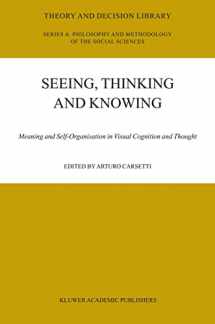
Seeing, Thinking and Knowing: Meaning and Self-Organisation in Visual Cognition and Thought (Theory and Decision Library A:, 38)
ISBN-13:
9781402020803
ISBN-10:
1402020805
Edition:
2004
Author:
A. Carsetti
Publication date:
2004
Publisher:
Springer
Format:
Hardcover
360 pages
FREE US shipping
Book details
ISBN-13:
9781402020803
ISBN-10:
1402020805
Edition:
2004
Author:
A. Carsetti
Publication date:
2004
Publisher:
Springer
Format:
Hardcover
360 pages
Summary
Seeing, Thinking and Knowing: Meaning and Self-Organisation in Visual Cognition and Thought (Theory and Decision Library A:, 38) (ISBN-13: 9781402020803 and ISBN-10: 1402020805), written by authors
A. Carsetti, was published by Springer in 2004.
With an overall rating of 3.7 stars, it's a notable title among other
books. You can easily purchase or rent Seeing, Thinking and Knowing: Meaning and Self-Organisation in Visual Cognition and Thought (Theory and Decision Library A:, 38) (Hardcover) from BooksRun,
along with many other new and used
books
and textbooks.
And, if you're looking to sell your copy, our current buyback offer is $0.3.
Description
According to Putnam to talk of “facts” without specifying the language to be used is to talk of nothing; “object” itself has many uses and as we creatively invent new uses of words “we find that we can speak of ‘objects’that were not ‘values of any variable’in 1 any language we previously spoke” . The notion of object becomes, then, like the notion of reference, a sort of open land, an unknown territory. The exploration of this land - pears to be constrained by use and invention. But, we may wonder, is it possible to guide invention and control use? In what way, in particular, is it possible, at the level of na- ral language, to link together program expressions and natural evolution? To give an answer to these onerous questions we should immediately point out that cognition (as well as natural language) has to be considered first of all as a peculiar fu- tion of active biosystems and that it results from complex interactions between the - ganism and its surroundings. “In the moment an organism perceives an object of wh- ever kind, it immediately begins to ‘interpret’this object in order to react properly to it . . . It is not necessary for the monkey to perceive the tree in itself. . . What counts is sur- 2 vival” .


We would LOVE it if you could help us and other readers by reviewing the book
Book review

Congratulations! We have received your book review.
{user}
{createdAt}
by {truncated_author}


